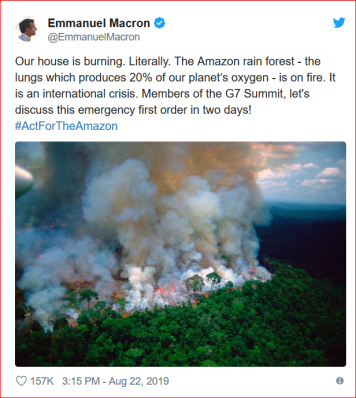8/22/19, “Fires in Brazil,“ EarthObservatory.NASA.gov
“Editor’s Note: This story was updated on 22 August 2019 to clarify our data source.”
“In the Amazon rainforest, fire season has arrived. The Moderate Resolution Imaging Spectroradiometer (MODIS) on NASA’s Aqua satellite captured these images of several fires burning in the states of Rondônia, Amazonas, Pará, and Mato Grosso on August 11 and August 13, 2019.

Above, August 11, 2019

Above, August 13, 2019
In the Amazon region, fires are rare for much of the year because wet weather prevents them from starting and spreading. However, in July and August, activity typically increases due to the arrival of the dry season. Many people use fire to maintain farmland and pastures or to clear land for other purposes. Typically, activity peaks in early September and mostly stops by November.
As of August 16, 2019, an analysis of NASA satellite data indicated that total fire activity across the Amazon basin this year has been close to the average in comparison to the past 15 years. (The Amazon spreads across Brazil, Peru, Colombia, and parts of other countries.) Though activity appears to be above average in the states of Amazonas and Rondônia, it has so far appeared below average in Mato Grosso and Pará, according to estimates from the Global Fire Emissions Database, a research project that compiles and analyzes NASA data. (Note that while the chart label says 2016, the 2019 data is listed on all of the plots as a green line. Roll your cursor over the green 2019 block below the plot to isolate the 2019 numbers.)”
“NASA Earth Observatory images by Lauren Dauphin, using MODIS data from NASA EOSDIS/LANCE and GIBS/Worldview and VIIRS data from NASA EOSDIS/LANCE and GIBS/Worldview, and the Suomi National Polar-orbiting Partnership. Caption by Adam Voiland.”
………………………………………
Added: Macron’s alleged picture of 2019 Amazon fires was fake:
8/21/19, “Stop Sharing Those Viral Photos of the Amazon Burning,” Mother Jones, Abigail Weinberg

“Update, 1:15 p.m. Friday, Aug. 23: Emmanuel Macron, the president of France, included one of the misleading viral photos [below] in a tweet Thursday. It has been retweeted more than 40,000 times and was embedded in a New York Times article about the fire.

…………………….
Added: Amazon rainforest relies on 40 million tons of nutrient-rich Sahara desert dust delivered yearly:

Image caption: Satellites can track African dust clouds as they migrate across the Atlantic Ocean. This NASA TOMS aerosol movie, which spans the interval June 13 through 21, 2001, shows such a cloud raining bits of the Sahara Desert over the Caribbean and the Gulf of Mexico. [more information]
1/3/2007, “Amazon forest relies on dust from one Saharan valley,“ newscientist.com, Richard Fisher
“The trees and plants in the Amazon rainforest rely on nutrient-rich dust from a single valley in the Sahara desert for sustenance, researchers have discovered.
Scientists know that millions of tonnes of mineral dust are blown from the Sahara desert to the Amazon basin each year. The dust helps keep the Brazilian rainforest soils fertile.Now, researchers have found that 56% of this dust comes from one place: the Bodélé depression in Chad, Africa. They also showed that three times more dust than previously thought is transported each year from the Sahara to the Amazon – over 40 million tonnes.
The team, led by Ilan Koren at the Weizmann Institute in Israel, used satellite and geological data to track the “dust parcel” across the Atlantic ocean….
The Bodélé valley is 200 times smaller than the Amazon basin, and forms only 0.2% of the Sahara itself. The reason the valley supplies so much dust is its location between two mountain ridges. It forms a funnel that accelerates the flow of air, not unlike a wind tunnel, allowing more dust to be carried. In winter, the valley produces an average of 700,000 tonnes of dust per day.
“Editor’s Note: This story was updated on 22 August 2019 to clarify our data source.”
“In the Amazon rainforest, fire season has arrived. The Moderate Resolution Imaging Spectroradiometer (MODIS) on NASA’s Aqua satellite captured these images of several fires burning in the states of Rondônia, Amazonas, Pará, and Mato Grosso on August 11 and August 13, 2019.

Above, August 11, 2019

Above, August 13, 2019
In the Amazon region, fires are rare for much of the year because wet weather prevents them from starting and spreading. However, in July and August, activity typically increases due to the arrival of the dry season. Many people use fire to maintain farmland and pastures or to clear land for other purposes. Typically, activity peaks in early September and mostly stops by November.
As of August 16, 2019, an analysis of NASA satellite data indicated that total fire activity across the Amazon basin this year has been close to the average in comparison to the past 15 years. (The Amazon spreads across Brazil, Peru, Colombia, and parts of other countries.) Though activity appears to be above average in the states of Amazonas and Rondônia, it has so far appeared below average in Mato Grosso and Pará, according to estimates from the Global Fire Emissions Database, a research project that compiles and analyzes NASA data. (Note that while the chart label says 2016, the 2019 data is listed on all of the plots as a green line. Roll your cursor over the green 2019 block below the plot to isolate the 2019 numbers.)”
“NASA Earth Observatory images by Lauren Dauphin, using MODIS data from NASA EOSDIS/LANCE and GIBS/Worldview and VIIRS data from NASA EOSDIS/LANCE and GIBS/Worldview, and the Suomi National Polar-orbiting Partnership. Caption by Adam Voiland.”
………………………………………
Added: Macron’s alleged picture of 2019 Amazon fires was fake:
8/21/19, “Stop Sharing Those Viral Photos of the Amazon Burning,” Mother Jones, Abigail Weinberg

“Update, 1:15 p.m. Friday, Aug. 23: Emmanuel Macron, the president of France, included one of the misleading viral photos [below] in a tweet Thursday. It has been retweeted more than 40,000 times and was embedded in a New York Times article about the fire.

…………………….
Added: Amazon rainforest relies on 40 million tons of nutrient-rich Sahara desert dust delivered yearly:

Image caption: Satellites can track African dust clouds as they migrate across the Atlantic Ocean. This NASA TOMS aerosol movie, which spans the interval June 13 through 21, 2001, shows such a cloud raining bits of the Sahara Desert over the Caribbean and the Gulf of Mexico. [more information]
1/3/2007, “Amazon forest relies on dust from one Saharan valley,“ newscientist.com, Richard Fisher
“The trees and plants in the Amazon rainforest rely on nutrient-rich dust from a single valley in the Sahara desert for sustenance, researchers have discovered.
Scientists know that millions of tonnes of mineral dust are blown from the Sahara desert to the Amazon basin each year. The dust helps keep the Brazilian rainforest soils fertile.Now, researchers have found that 56% of this dust comes from one place: the Bodélé depression in Chad, Africa. They also showed that three times more dust than previously thought is transported each year from the Sahara to the Amazon – over 40 million tonnes.
The team, led by Ilan Koren at the Weizmann Institute in Israel, used satellite and geological data to track the “dust parcel” across the Atlantic ocean….
The Bodélé valley is 200 times smaller than the Amazon basin, and forms only 0.2% of the Sahara itself. The reason the valley supplies so much dust is its location between two mountain ridges. It forms a funnel that accelerates the flow of air, not unlike a wind tunnel, allowing more dust to be carried. In winter, the valley produces an average of 700,000 tonnes of dust per day.
Journal reference: Environmental Research Letters (DOI: 10.1088/1748-9326/1/1/014005)”
..............

No comments:
Post a Comment